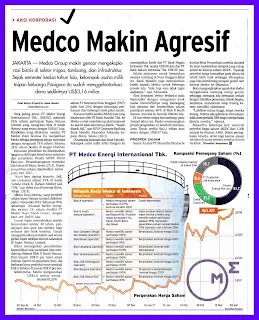In a bid to exploit “offshore” momentum to its advantage, publicly listed integrated energy company PT Medco Energi Internasional has completed a full acquisition of INPEX NATUNA Ltd., which operates in the South Natuna Sea. The move, however, signals that other foreign companies may follow INPEX’s exit.
In a statement issued on Monday, Japan’s INPEX Corporation announced that it had decided to sell all its shares in INPEX NATUNA Ltd., its wholly owned subsidiary, which holds a 35 percent participating interest in the South Natuna Sea’s Block B, to PT Medco Daya Sentosa, a subsidiary of Medco Energi.
INPEX Corp. attributed the US$ 167 million share sale to the policy of optimizing its global asset portfolio, given that the contribution of INPEX NATUNA in terms of income and cash flow was expected to become relativelylimited after almost 40 years of oil production.
By transferring ownership to Medco Daya Sentosa, INPEX Corp. has followed in the footsteps of energy giant ConocoPhillips, which gave up ownership of ConocoPhillips Indonesia Inc. Ltd. and ConocoPhillips Singapore Operations Pte. Ltd. to Medco Energi in November 2016.
ConocoPhillips Indonesia was the operator of the South Natuna Sea Block B with a 40 percent working interest and the operator of the West Natuna Transportation System, while ConocoPhillips Singapore Operations oper-ated the onshore receiving facility in Singapore.
With the latest acquisition, Medco now holds a 75 percent participating interest in the block and the remaining 25 percent is controlled by another energy giant Chevron Corp. through its Chevron South Natuna B Inc.
“The acquisition is a game changer for Medco as we want to help the government solve its energy problem,” Medco Energi Internasional president commissioner Muhammad Lutfi told.
The share acquisition is expected to be completed in May and Medco will use internal cash reserves and bank loans to finance the takeover. Lutfi claimed South Natuna would be the starting point for the company to venture deeper into offshore production. It is the first and only offshore block for Medco as its other Iive production facilities are located onshore, such as the South Sumatra Block and Lematang Block.
“We are sure we can increase the production of Natuna. We already have the human resources and our directors are experts in offshore production,” he said. The government previously decided that the gas rich Masela Block in the Malukus would be developed in an offshore scheme.
According to data from INPEX Corp., the South Natuna Sea Block B has a water depth of approximately 50 to 55 meters. The average production rate for the block for the year 2016 was approximately 20,000 barrels per day (bpd) of crude oil, 197 million standard cubic feet per day (mmscfd) of natural gas and 6,000 barrels per day (bpd) of liquefied petroleum gas.
The oil and gas production decreased 6.54 percent and 33.45 percent in 2016, respectively. In 2015, the block produced 21,400 bpd of crude oil and 296 mmscfd of natural gas, as shown by data from the Upstream Oil and Gas Regulatory Task Force (SKK Migas). ReforMiner Institute researcher Pri Agung Rakhmanto lauded Medco’s acquisition of INPEX NATUNA, saying it was an achievement tor a local firm to take over an international oil company
However, he said the current low oil price might force other foreign firms to rearrange their portfolios, and they too might relinquish ownership of operations in Indonesia. “INPEX has stake in Masela, that’s why it had the courage to sell Natuna.”
Energy expert John Sadrak Karamoy said that along with decreasing productivity regulatory uncertainty was also a major factor behind foreign oil and gas players’ decision to leave Indonesia.
“Those foreign players wanted to quit because we do not have consistency in regulations,” he said. A major example is when the government introduced the new gross-split sliding scale to slowly replace cost recovery, which supposedly gives contractors much more freedom over their activities, but may also force them to rein in expenditure.
Jakarta Post, Page-13, Wednesday, March, 29, 2017















